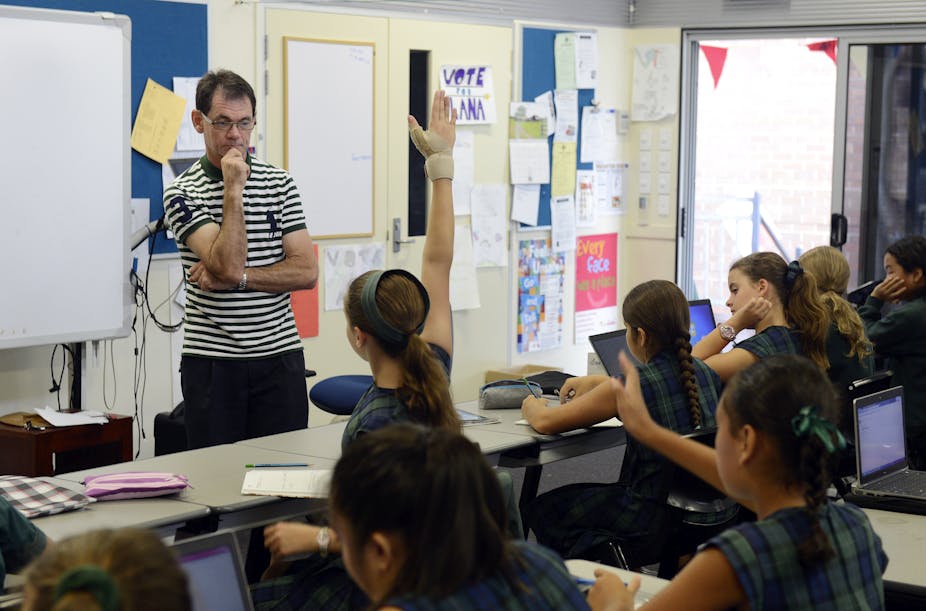Teachers teach and students learn, so why the need for a review into how teachers learn? The review of teacher education announced in February seems driven largely by concerns that Australian students are going backwards in international student assessments when compared to the rest of the world.
However, the Teacher Education Ministerial Advisory Group asks fundamentally the same questions as previous reviews of teacher education have asked. Commentators state that each inquiry reaches much the same conclusions and makes much the same recommendations, yet little changes.
Already, we know that recommendations relating to effective models of teacher education and recommendations for a national system of teacher education are likely. There will also be much debate about what can be funded and who should fund it.
However, there are fundamental questions the review has missed. I’ve set out four things the review should be asking:
1. What sort of education do we want for our kids?
To review the way our teachers learn, we have to think about what we consider a world-class education. Until we define the sort of education we want our kids to have, it is hard to decide how our teachers should be taught.
This could be informed by the Melbourne Declaration on Educational Goals of Young Australians, made by all Australian education ministers in 2008. The first goal is that “Australian schooling promotes equity and excellence”. The second aims for “all young Australians to become successful learners, confident and creative individuals, active and informed citizens”.
These goals are considerably more comprehensive than what results from student testing can tell us and reflects a far more mature understanding of quality teaching. These goals could be a powerful starting point for the review to identify the graduate teacher capabilities that need to be developed.
2. Who’s responsible for student learning?
The review says that “the quality of the teacher is the single greatest in-school influence on student achievement”, but says little about out-of-school influences. While teacher quality is important, so are the contexts in which teaching and learning takes place.
Commentators such as the University of Queensland’s Bob Lingard have said much of this debate reductively suggests that it is the teacher who is the single most important influence. Using an evidence-based approach, he argues that policy (and much of the media commentary) understates the influence of culture, history, structural inequality, gender, race, ethnicity and indigenous disadvantage.
Melbourne Educational Research Institute director John Hattie identified six sources of relative influence on student learning and how much they account for: students themselves (about 50%), home (about 5-10%), schools (about 5-10%), principals (already accounted for in the school variance), peer effects (about 5-10%) and teachers (about 30%).
This commentary proposes an alternative to the unhelpful criticism of our teachers for outcomes beyond their control. Australia is in decline in measures of equity, according to the Program for International Student Assessment, which reflects wider – and worsening - social inequalities, disadvantage and structural social challenges.
Quality teaching is more inclusive of all who contribute to student learning. Parents and communities need to be involved, and the abilities, attitudes and aspirations of students themselves should be taken into account.
So, an alternative is for the review to understand that a quality teaching approach achieves better student learning outcomes rather than focusing only on developing quality teachers.
3. Is any of this new?

In an increasingly digital world, this review needs to contribute something new to teacher education. Graduate teacher capabilities need to be brought up to date with the technology of the 21st century.
Previous reviews of teacher education seem to have been written for a pre-1993 analogue world and constructed through the lens of industrial-age models of schooling. The review’s questions could have been written for a teacher education review 30 or 40 years ago.
The Melbourne Declaration stated:
In this digital age, young people need to be highly skilled in the use of ICT. While schools already employ these technologies in learning, there is a need to increase their effectiveness significantly over the next decade.
Graduate teachers require more than knowledge about the content and how to teach it. They need to be able to develop ways to use technology for learning. This review is an opportunity to discuss things that haven’t been discussed in previous years and to get the changing nature of pedagogy on the agenda.
4. How does the review solve the problems in Australian teacher education?
No-one is denying teacher education in Australia could be better. There are many issues and conflicts, which Margaret Lloyd has identified in her report Troubled Times in Australian Teacher Education. Some of these include literacy and numeracy standards, entry and participation rates, and public perceptions of teachers.
Lloyd identified considerations to deal with these tensions, the main one being a fundamental change in the way teacher education is regulated. Teacher education is highly regulated, and regulations are replete with duplication, contradictions and anomalies. These need to be ironed out before any reforms can be successful. It is also uncoordinated at the national level, which should be reconsidered.
This review, like the ones before it, fails to address the fundamental issues facing teacher education, and until it does will have just as much effect as the last reviews. That being, not very much. Please add to this important conversation and get your submissions in by June 13.

